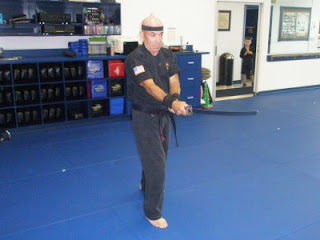So far, we've learned three parts of our first cutting kata. They're cool, fun, and really hard to remember. There's new words for the handle, the part that protects your hand, the thing (sheath) that you put it in, the motions you make to shake the blood off the sword, and the motion for putting the sword back in it's holder. I can't remember any of them. Do you? If so, please send them along.
I did get a few pictures of stances (thanks Joe) and a very simple video of one of the three "cutting forms."




The fun gets funner. We now have swords as part of the curriculum!
This is a basic demo, very slow, of Cutting form 2. Basically:
- upblock
- slice across on the 45
-slide across on the horizontal
- overhead strike
- hit the sword to clearn off the blood - chabusi?
- resheath the sword while in a cool sideways stance
- salute.
1 comment:
We've been learning the sword for the past month in Rochester and having a blast doing it. So far we've learned the eight positions, the four types of cuts, the three cutting forms, XMA Sword Form 1 Kata, and the inside and outside figure eights with the sword. To answer some of your questions, the name of the hand guard on the bokken is the Tsuba (rhymes with tuba.) The handle of the bokken is called the Tsuka. The sheath for the sword is called a Saya. The action of drawing the sword is called Batto. The action of cleaning the blood from the sword (either by flicking the sword or striking the sword) is called Chiburi. Returning the sword to the saya is called No-to.
By the way, great pictures of the cutting stances. Your description of Cutting Form 2 is accurate but Joe's excellent performance doesn't quite match the description.
Post a Comment